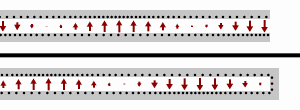- Elements of electric circuits can be interconnected in several way.
- Need to understand some basic concepts of network topology.
- Branch(es)⇒ Represents a single element. (ex: voltage,resistor & etc.)
- Node(s)⇒ Meeting point between the two or more branches.
- loop(s)⇒ Any closed path in a circuit.
example(1):
- How many branches and nodes for the following circuit?

Answer: There were 5 branches and 3 nodes.
example(2):
There were:
5 branches
- 1 voltage source
- 1 current source
- 3 resistors
3 nodes
example(3):
- How many branches, nodes and loops for the following circuit?
Answer: There were 7 branches, 4 nodes, and 10 loops.
Kirchhoff's Current Law (KCL)
- The algebraic sum of current entering/leaving a node (or closed boundary) is zero.
- current enters- positive (+)
- current leaves- negative (-)
- ∑ current entering = ∑ current leaving
example KCL(1):
- Given the following circuit, write the equation for currents.
example KCL(2):
- Current in a close boundary.
example KCL(3):
- Use KCL to obtain currents i1, i2, and i3 in the circuits.
Answer:
A= 1A+i1=2A+10A
i1=12A-1A
i1=11A
B= 3A+2A=1A+i2
5A=1A+i2
i2=4A
C= i3+10A=11A
i3=11A-10A
i3=1A
Take note:
Series=add up voltage
Parallel=equal voltage
Kirchhoff's Voltage Law (KVL)
- Applied to a loop in a circuit.
- According to KVL→ The algebraic sum of voltage (rises or drops) in a loop is zero.
From positive → negative
+Vs-V1-V2-V3=0
example KVL(1):
- Use KVL to obtain v1, v2 and v3.
Answer:
+20+25-10-v1=0
V1=35v
+10-15+v2=0
v2=-10+15
v2=5V
+v1-5-v3=0
35-5-v3=0
v3=30V
example KVL(2):
- Use KVL to obtain v1 and v2.
Answer:
+10v+12v+6v-v1-v1=0
28v-2V1=0
28V/2=2V1/2
V1= 14V
+V2-12V-10V=0
+12V-22V=0
V2= 22V
example KVL(3):
- Calculate power dissipated in 5Ω resistor.
Answer:
P= iv = i²R = v²/ R
V 5Ω = 5i
45-10i + 3vo – 5i =0
vo = 10i
45-Vo + 3vo -5i = 0
i = Vo/10
45-Vo +3vo -5 (Vo/10) = 0
LEARNING/SUMMARY
- In determining the nodes, always look for the intersection or cross section of two elements.
- Branches are also called as element. So, do not get to far and do not make hard on yourself.
- Loops are any closed path in a circuit.
- At our first encounter, we had suffered like a chaos in our mind. But this is what we tell you, our learners, always circle round in clockwise and use the sign upon exit. This is applicable KVL. But you can choose counterclockwise as well. But you know, just like the clock, it goes from left to right the reason why you read the clock rightly.
- We also advice you take layman's term for yourselves but make sure you have understood the fundamental concepts behind each thing. Just like in KCL, positive is equals to negative; where enters to you life, you will be positive. And so as if people leave you behind, you will be negative already. But you will still be equal in a way that people may leave you but there are people who will come to you.






































